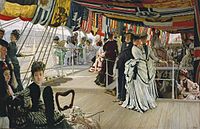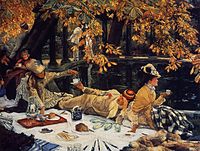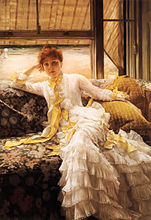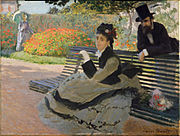Women’s fashion in 1870s, the style of this period is called impressionist fashion. Women’s clothing from this time is often depicted on paintings by Impressionist painters, such as Monet and Renoir. Women’s clothing is characterized by a gradual return to a narrow silhouette after the full-skirted fashions of the 1850s and 1860s.
By 1870, fullness in the skirt had moved to the rear, where elaborately draped overskirts were held in place by tapes and supported by a bustle. This fashion required an underskirt, which was heavily trimmed with pleats, flounces, rouching, and frills. This fashion was short-lived (though the bustle would return again in the mid-1880s), and was succeeded by a tight-fitting silhouette with fullness as low as the knees: the cuirass bodice, a form-fitting, long-waisted, boned bodice that reached below the hips, and the princess sheath dress. Sleeves were very tight fitting. Square necklines were common.
Day dresses had high necklines that were either closed, squared, or V-shaped. Sleeves of morning dresses were narrow throughout the period, with a tendency to flare slightly at the wrist early on. Women often draped overskirts to produce an apronlike effect from the front.
Evening gowns had low necklines and very short, off-the-shoulder sleeves, and were worn with short (later mid-length) gloves. Other characteristic fashions included a velvet ribbon tied high around the neck and trailing behind for evening in a similar style to Georgian era fashion (the origin of the modern choker necklace).
The train has gradually risen on the hips to become turn that are adorned with ribbons or lace.
The silhouette is radically transformed over the course of the decade, with the train going up on the hindquarters as the dress adjusts to the body, thus forgetting the crinoline.
The hats become small, they are mostly filled with flowers, ribbons or veils and are bent on the front.
The coats are loose and long unless they match the dress so they are adjusted instead.
The umbrella remains an essential accessory in summer, even if its size is reduced. The women take a fortnight in their suitcases for their holidays in seaside resorts.
Skirts and dresses
The fabric of the skirt is folded more and more on the hips and carried over rolls or cushions, so that around 1870 the queue de Paris or tournure arises. The afternoon gown has half-length sleeves with lace ribs and a square neckline with ruffles.
The trend for broad skirts slowly disappeared during the 1870s, as women started to prefer an even slimmer silhouette. Bodices remained at the natural waistline, necklines varied, while sleeves began under the shoulder line. An overskirt was commonly worn over the bodice, and secured into a large bow behind. Over time though, the overskirt shortened into a detached basque, resulting in an elongation of the bodice over the hips. As the bodices grew longer in 1873, the polonaise was thus introduced into the Victorian dress styles. A polonaise is a garment featuring both an overskirt and bodice together. The tournure was also introduced, and along with the polonaise, it created an illusion of an exaggerated rear end.
By 1874, skirts began to taper in the front and were adorned with trimmings, while sleeves tightened around the wrist area. Towards 1875 to 1876, bodices featured long but even tighter laced waists, and converged at a sharp point in front. Bustles lengthened and slipped even lower, causing the fullness of the skirt to further diminish. Extra fabric was gathered together behind in pleats, thus creating a narrower but longer tiered, draped train too. Due to the longer trains, petticoats had to be worn underneath in order to keep the dress clean.
After 1875 the tour disappears: the space of the fabric is lower and the skirt gets a drag. The hair is loosely raised, sometimes with curls or braids, and a small hat on the forehead.
However, when 1877 approached, dresses moulded to fit the figure, as increasing slimmer silhouettes were favoured. This was allowed by the invention of the cuirass bodice which functions like a corset, but extends downwards to the hips and upper thighs. Although dress styles took on a more natural form, the narrowness of the skirt limited the wearer in regards to walking.
 1870 |
 1870 |
 1872 |
 1873 |
 1874 |
|---|---|---|---|---|
 1875 |
 1876 |
 1877 |
 1877 |
 1878 |
Tea gowns and artistic dress
Under the influence of the Pre-Raphaelite Brotherhood and other artistic reformers, the “anti-fashion” for Artistic dress with its “medieval” details and uncorseted lines continued through the 1870s. Newly fashionable tea gowns, an informal fashion for entertaining at home, combined Pre-Raphaelite influences with the loose sack-back styles of the 18th century.
Leisure Dress
Leisure dress was becoming an important part of a woman’s wardrobe. Seaside dress in England had its own distinct characteristics but still followed the regular fashions of the day. Seaside dress was seen as more daring, frivolous, eccentric, and brighter. Even though the bustle was extremely cumbersome, it was still a part of seaside fashion.
Undergarments
With the narrower silhouette, emphasis was placed on the bust, waist and hips. A corset was used to help mold the body to the desired shape. This was achieved by making the corsets longer than before, and by constructing them from separate shaped pieces of fabric. To increase rigidity, they were reinforced with many strips of whalebone, cording, or pieces of leather. Steam-molding, patented in 1868, helped create a curvaceous contour.
Skirts were supported by a hybrid of the bustle and crinoline or hooped petticoat sometimes called a “crinolette”. The cage structure was attached around the waist and extended down to the ground, but only extended down the back of the wearer’s legs. The crinolette itself was quickly superseded by the true bustle, which was sufficient for supporting the drapery and train at the back of the skirt.
Hairstyles and headgear
In keeping with the vertical emphasis, hair was pulled back at the sides and worn in a high knot or cluster of ringlets, often with a fringe (bangs) over the forehead. False hair was commonly used. Bonnets were smaller to allow for the elaborately piled hairstyles and resembled hats except for their ribbons tied under the chin. Smallish hats, some with veils, were perched on top of the head, and brimmed straw hats were worn for outdoor wear in summer.
Wraps and Overcoats
The main kind of wrap that dominated in the 1870s were capes and jackets that had a back vent in order to make room for the bustle. Some examples are the pelisse and the paletot coat.
Style gallery 1870–74
 1 – 1870 |
 2 – 1870 |
 3 – 1870 |
 4 – 1871 |
 5 – 1872 |
|---|---|---|---|---|
 6 – 1872 |
 7 – 1874 |
 8 – 1874 |
 9 – 1874 |

10-1873
|
1.Walking dress of 1870 has a tiered and ruffled skirt back.
2.1870 fashion plate shows jacket-bodices with draped and trimmed skirts in back. Ruffles and pleated frills are characteristic trimmings of the 1870s.
3.1870s American bathing dress, with ankle length skirt, long pants, and long sleeves
4.French morning dress of 1871 features a narrow red ribbon at the low neckline and a large matching bow with streamers at the back waist.
5.Dolly Varden dresses of 1872 demonstrate the popular fashion of the early 1870s known as “Dolly Varden”
6.Artistic dress of the early 1870s. Portrait of Mrs. Frances Leyland by Whistler.
7.Outdoor dresses of 1874 feature overskirts caught up with buckled ribbons. Jacket-bodices have cuffs and high necklines. Small straw hats with flat crowns and long ribbons (similar to men’s boaters) are worn tipped forward.
8.Backview of a dress of 1874 shows the draping of the overskirt and the slight train on the underskirt. France.
9.Dress of 1874 with draped overskirt and ruffled underskirt.
10.Bustles and elaborate drapery characterize evening dresses of the early 1870s. The gentleman wears evening dress. Detail of “Too Early” by Tissot, 1873
Style gallery 1874–79
 1 – 1874 |
 2 – 1875 |
 3 – 1875 |
 4 – 1877 |
 5 – 1878 |
|---|---|---|---|---|
 6 – 1878 |
 7–1876 |
 8-1878 |

9-1879
|

10-1870s
|
1.Tight dresses with long trains of the mid-1870s are trimmed with pleated ruffles, bows, buttons, and braid, and are worn with hats with ribbon streamers.
2.French evening gown is festooned with flowers and is worn with mid-length white gloves and a black neck ribbon. The high-knotted hairstyle is typical of the mid-1870s.
3.Morning dress of c. 1875 has a trailing overskirt and is trimmed with a profusion of ruffles and ribbons. Hair is braided into a crown high on the head.
4.Semi-sheer dresses of c. 1877 show back fullness beginning at hip-level rather than the waist as in 1874–5. The tight, princess-line dress on the right fits smoothly to the body from the shoulders to the lower hips.
5.Evening gown of 1878 has a long train and a squared neckline. It is worn with opera-length gloves.
6.Jacket and skirt costume of 1878 features a long train trimmed with pleated frills and ruching. Matching ruching trims the cuffs of the sleeves.
7.Court gown of 1876 features a train, long white gloves and the three white ostrich feathers representing the Prince of Wales plumes in the hair.
8.Hunting costume is made green wool, Scotland, c. 1878.
9.Countess Brownlow in artistic dress, 1879.
10.1870s Dress
Impressionist fashion
 1-1872 |
 2-1873 |
 3-1875 |
 4-1875 |
 5-1875 |
|---|
1.Springtime, 1872
2.Camille Monet on a Garden Bench, 1873
3.Woman with an Umbrella (1875)
4.Camille au métier (1875)
5.Madame Monet in a Japanese costume
Source from Wikipedia
